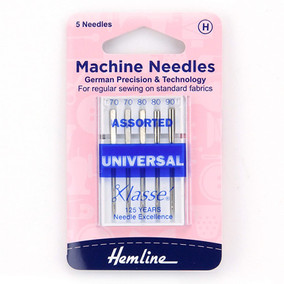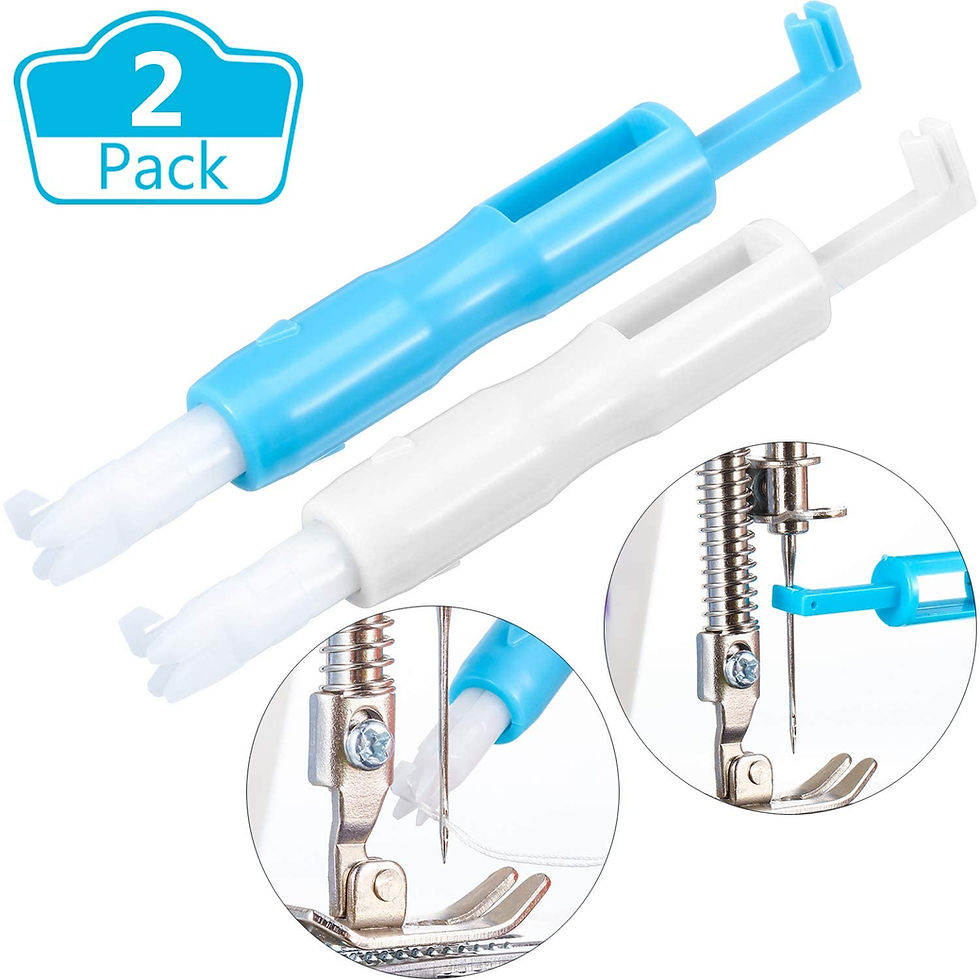All about sewing machine needles - straight to the point
- Kasia Kochanska
- Jul 1, 2020
- 5 min read
Updated: Aug 22, 2021
Fact: A sewing machine needle can massively help or completely destroy your sewing project!
That's the honest true and everyone who has ever tried the bad quality needles will agree with it.
Needles are not a money saving feature. You can get a cheap ruler, a chalk or an iron board, but never ever get cheap, bad quality needles from the shop that is not selling sewing stuff daily. Beside, even good quality needles are not that expensive so it's not worth saving pennies on the needles.
"What can happen if I use bad quality needles?" you may say.
First of all, your needle may not work at all 😫! The groove, where the thread is hiding, might be too shallow and the thread won't get looped with the bottom thread = no stitch formed, maybe the rough edges of the needle will cut your best quality thread all the time (and I really mean all the time!), again hours of your time wasted wondering what's wrong ... and of course your precious fabric might get destroyed, plucked or get some holes in it, just to name a few of possible disasters.
No, we don't won't to buy bad quality needles.
So, since we have agreed that we need the good quality needles, you'll ask : what to buy?
First: buy from the shop (local or online) which sells the sewing haberdashery daily, as they will be ashamed to sell bad stuff, lol, logic, right 😎?
There are few brands on the market that are good, reliable and recommended and they won't disappoint you:
Schmetz (rebranded Bernina)
Organ (rebranded Janome)
Prym
Singer
Klasse (Hemline)
So whenever you buy, buy a good brand. 👍
When choosing the right sewing machine needle for a particular project, you need to make two choices – you need to choose the needle size and the needle type. Let’s talk about a needle size first.
Needles sizes
Sewing machine needles come in a variety of sizes and are used for different fabrics.
General rule: fine fabric - fine needle (lower number), thicker fabric - thicker needle (higher number). Please refer to the detailed breakdown below.
For very fine fabrics like silk, chiffon, organza, voile or lace you may use needles sizes:
8 (60), 9 (65), 10 (70) & 11 (75)
For light weight fabrics such as cotton, heavier silks, light linen, muslin, synthetics, spandex or Lycra needles sizes: 12 (80) or 14(90)
For medium weight fabrics like velvet, fine corduroy, linen, tricot, knits or fleece use a needle size : 16 (100)
For heavy weight fabrics such as denim, leather, canvas, suiting needle: 18 (110)
For very heavy weight fabrics like heavy denim, upholstery fabric, faux fur use needles:
19 (120) or 20 (125)
and for extra heavy fabrics use a needle size : 21 (130).
Needles types
Sewing machine needles also come with the different "type description" on the packet, which I believe causes even more confusion for the first time buyers. Jersey, universal, microtex and much more. So what are they for??
Most currently manufactured needles are designated according to "type", and fall into the following categories:
Universal
The universal class of needles are used on domestic machines. "Universal" refers to the shape of the needle shank and length of the needle rather than the actual sewing application or point. The most notable feature of universal needles is the flat face on the needle shank which helps to ensure the needle is inserted correctly. A universal class needle is designed to be used on virtually any domestic sewing machine. They do not fit industrial sewing machines. This is a type I use most!
Embroidery
These needles come with an extra large eye and a specially shaped scarf to prevent embroidery thread from shredding.
Ballpoint and Jersey
Similar to a universal needle but has rounded edges and is not tapered the same way. Intended for closely knit fabrics where the rounded tip will push the weave out of the way rather than cut through it.
Jeans/ Denim
Intended for tightly woven cottons such as canvas. Has a strong, sharp point and very slender eye.
Wing
Needle has distinct "wings" on either side of the eye which hold the fabric open. Often used on hems and borders, and for decorative finishing. A larger size needle will leave a larger hole in the final piece of sewn fabric.
Leather
These have a distinct triangular point to help the needle make a large, clean hole in non-woven materials like vinyl.
Metallic
Similar to an embroidery needle with a large eye and extra long scarf, but also includes a Teflon coating to the eye so that metallic threads will not shred when used.
Quilting
Designed with an extra strong shaft and with a tapered point to penetrate multiple layers of woven fabrics without breaking and without shredding either the thread or the fabric being sewn.
Overlocker (Serger)/ Industrial
These needles can only be used in serger and overclocking machines.
Microtex/ Sharps
More slender and sharper than the universal needle. Suitable for fine woven fabrics, but also compatible for quilting and applique. Brilliant for tightly woven fabrics.
Stretch
These needles are intended for use on fabrics with a significant amount of Spandex or similar fabric content. Rounded tip and specialised scarf and eye to prevent skipping.
Top-stitching
These have exceptionally sharp points and a very large eye to accommodate thick decorative top-stitching threads. Very similar to the leather needle.
Twin/ Triple
Needles set in pairs or in groups of three on a single shaft designed to sew multiple, usually decorative, threads at once. These require specialised machinery to accommodate the extra needles, as well as multiple thread feeds. The twin or triple designation is usually accompanied by another needle type specification such as "stretch" or "denim", etc.
I also use a twin needle for finishing hems when working with knits.
I always have in my stash: universal, stretch, jersey, ball point, denim, microtex, quilting, overlocker, leather and twin needles.
That's a lot! you'll say, but if you are sewing constantly, you'll also soon find yourself with the stash that fits your needs too. The last thing you need is to break your needle on the last straight and not be able to finish your project.
Are the needles so different?
Yes, if you look closely, you'll find big differences in the points and grooves lengths that helps to sew through certain fabrics.

Colour coding
Some sewing machine needles are colour coded, but different manufactures are coding them differently, so I'm not going to write about it. If you are interested in colour coding please visit the link, there is a very good breakdown for it:
Remember : choosing the needle size correctly for your project is as important as choosing the needle type.
You should always choose the size of your needle based on the fabric you are working with and the weight of the thread you are using. 😊👍
Why do sewing machine needles break?
Breaking a sewing machine needle can be a frustrating and rather scary (not to mention dangerous!) occurrence. I always close my eyes if I hear the needle's breaking sound!
Here are some possible causes of broken needles, knowing it, may help you avoid this unpleasant experience:
- Needle type or size is not suitable to the fabric
- Pins left in the fabric - don't forget to remove the pins as you sew
- Needle is not inserted properly or it's bent
- Poor maintenance of the bobbin area, it might be catching somewhere
- Thread is not unwinding correctly
- The machine is not threaded correctly
How often shall I change my needle?
It is recommended to change the needle for every new project, or up to 10 hours of sewing. Different manufacturers advice a bit differently, the most important is to make sure you always use sharp, not bent and correct needle to your project.
If you are looking for some needles here are some links to help you find some good quality needles! Click on the picture to get redirected to the sellers.
Hope this post was helpful!
Don't forgrt to Subscribe for more!
Monthly free pattern, blog notifications directly into your email box! 😍
Happy sewing!💖
ps. If you are having troubles threading your machine here is a little helper, click on the picture for details! 😉😉😉

















Comments